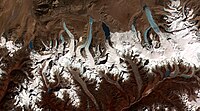Glacial motion

Ok, kiddo, let's talk about glaciers and how they move. You know how ice cubes are hard and don't move much? Well, glaciers are like really, really big ice cubes. But they're not just sitting still - they actually move, kind of like a really slow river.
Now, you might be wondering, "How can ice move if it's not melting?" (Great question, by the way!) Here's the thing: even though glaciers are made of ice, they're not like the popsicles you eat on a hot day. They're actually under a lot of pressure from the weight of all the ice on top of them. This pressure makes the ice at the bottom of the glacier more squished and compacted than the ice on top. And when something is squished and compacted like that, it's easier for it to slide and move.
But that still doesn't explain how glaciers actually move. Well, scientists think that there are two main ways that glaciers move:
1. Plastic flow: Remember how I said the bottom of the glacier is more squished and compacted? This makes the ice act like something called a "plastic," which means it can bend and flow without breaking. So over time, the ice at the bottom of the glacier stretches and flows in the direction the glacier is moving.
2. Basal slip: This is when something called "meltwater" - which is just water that comes from melting ice and snow - gets between the bottom of the glacier and the ground it's sitting on. This makes it easier for the glacier to slide along, kind of like how it's easier to slide on a wet floor than a dry one.
So between the plastic flow and the basal slip, glaciers can move pretty slowly (we're talking like a few inches a day to a few feet a year). But over time, this movement can really add up, and that's how glaciers can reshape the landscape around them. Pretty cool, huh?
Now, you might be wondering, "How can ice move if it's not melting?" (Great question, by the way!) Here's the thing: even though glaciers are made of ice, they're not like the popsicles you eat on a hot day. They're actually under a lot of pressure from the weight of all the ice on top of them. This pressure makes the ice at the bottom of the glacier more squished and compacted than the ice on top. And when something is squished and compacted like that, it's easier for it to slide and move.
But that still doesn't explain how glaciers actually move. Well, scientists think that there are two main ways that glaciers move:
1. Plastic flow: Remember how I said the bottom of the glacier is more squished and compacted? This makes the ice act like something called a "plastic," which means it can bend and flow without breaking. So over time, the ice at the bottom of the glacier stretches and flows in the direction the glacier is moving.
2. Basal slip: This is when something called "meltwater" - which is just water that comes from melting ice and snow - gets between the bottom of the glacier and the ground it's sitting on. This makes it easier for the glacier to slide along, kind of like how it's easier to slide on a wet floor than a dry one.
So between the plastic flow and the basal slip, glaciers can move pretty slowly (we're talking like a few inches a day to a few feet a year). But over time, this movement can really add up, and that's how glaciers can reshape the landscape around them. Pretty cool, huh?
Related topics others have asked about:
